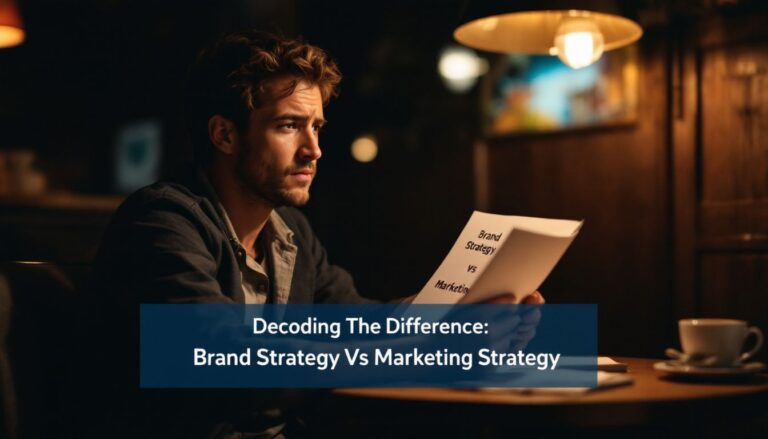Do you find it hard to clearly show customers why your brand is the best choice? Many business owners face this same challenge. After careful research, it’s clear that sharing a simple yet powerful brand message can grab customer interest by highlighting unique benefits first. 2 In this article, you’ll learn exactly what a Brand Value Proposition is and how it helps set your company apart from competitors. 1 Keep reading to discover simple steps for building a strong value proposition for your own business! 3
Key Takeaways
- A brand value proposition clearly explains why customers should pick you over competitors—without extra fluff or confusion.
- Effective value propositions zero in on real customer issues, rather than just rattling off product specs.
- Short, catchy statements stick better—think Nike’s “Just Do It”, or Walmart’s “Save Money. Live Better”.
- Be sure your promise matches what’s actually true—Kmart said it had lower prices, but Walmart beat them in reality.
- Brands like Amazon, Zappos, and Whole Foods build trust by consistently meeting specific customer needs and keeping their promises.
What Is a Brand Value Proposition?

We covered branding basics, now let’s see what helps a brand really pop in the market.
A brand value proposition is a short, clear statement. It explains why customers should choose your product instead of others. I see it as the key advantage that sets your brand apart.
This brief statement clearly answers, “Why should I buy from you?” Think of Apple’s tagline “Think Different” or Bounty’s “The Quicker Picker Upper”—these stick with you and clearly highlight their standout benefit.
Your value proposition needs to clearly communicate what makes your company special, and why your customers should care about it. Top brands often use value propositions to build a connection with customers and drive sales. 1 The best value propositions clearly solve customer problems and meet real needs, rather than just giving a list of product features.
Why a Brand Value Proposition Matters
A clear brand value proposition is the backbone of my marketing strategy. I’ve seen it help brands rise above crowded markets—and create real connections with customers. Nike’s “Just Do It”, or Coca-Cola’s “Open Happiness”, stick in your memory and build lasting brand equity.
Simple phrases like these, do more than sell—they spark emotions, and that keeps customers loyal. Working with small businesses, I’ve noticed clear and genuine value statements drive growth and build trust. 1
A strong value proposition isn’t just words or slogans. It shapes every marketing decision and helps staff clearly understand what makes their brand unique. McDonald’s “I’m Lovin’ It” succeeds because customers see it everywhere, from TV ads to signs in stores.
Great value statements clearly show how the brand solves customer problems in an honest and real way. Now…here’s what goes into making a meaningful brand value proposition. 1
Key Components of a Strong Brand Value Proposition
A strong brand value proposition needs key elements that make customers say “yes” to your products instead of your competitors – read on to learn what makes your message stick in the minds of your target market.
Clear and direct messaging
I’ve seen how clear messages cut right through today’s busy noise. Your brand needs to hit quick and strong. Wal-Mart gets it just right with “Save Money. Live Better”. Four words—telling customers exactly what’s in it for them.
Dollar Shave Club does the same with “Shave Time. Shave Money”. Simple phrases stick better than wordy explanations or flashy language. 3
The best value messages skip product lists. They motivate people by clearly stating benefits instead. Campbell’s “Soup That Eats Like a Meal” does all that in seconds. Easy, direct wording connects more strongly with customers.
Nike nailed this too—”Just Do It” inspired millions into buying shoes and workout clothes… all from three simple words. 2
Unique benefits that differentiate the brand
A clear, unique benefit is the heart of a strong brand proposition. Your brand needs something distinctive—maybe an innovation, great quality, appealing prices, sustainability, or a better customer experience. 4 M&Ms did this perfectly, with their famous slogan, “Melts in Your Mouth, Not in Your Hands”, highlighting a benefit no other candy brand claimed. Great value propositions tackle real customer problems competitors just can’t handle.
For your audience, your brand benefits must matter. Kellogg’s slogan “Snap! Crackle! Pop!” highlights the fun sensory experience of enjoying their cereal. Verizon’s classic slogan, “Can You Hear Me Now? Good”, directly targeted frustration with cell phone service issues.
Unique selling points like these build loyalty by connecting genuinely to customer needs. The strongest differentiators aren’t about cool features—they’re about solving practical problems and giving customers exactly what they’re after. 5
Focused on customer needs and desires
I center my brand’s message around what customers really care about. My research proves the strongest brands tap into actual customer concerns to stay meaningful. Great value statements clearly address people’s real needs, not just what my company hopes to sell.
Doing careful market research ahead of creating my message helps identify exactly what customers want most. Brands like Apple and Zappos succeed because they fix problems customers actually have. 6
Customer needs shift quickly, and I have to stay aware. My value proposition is strongest when it directly matches what people currently look for. Clear and direct messages focused on specific desires always beat complicated promises.
At its core, the proposition should visibly solve a practical issue or match a desire my audience actually values. This approach builds customer trust, turning new buyers into committed brand supporters.
Value Proposition vs. Brand Promise
Brands often confuse value propositions and brand promises—but they’re different things. Value propositions highlight specific benefits customers get from your product. They clearly explain why someone should choose you, instead of other options. 3 Brand promises go further. They’re steady commitments that you’ll deliver exactly what you say—every single time. Consider Kmart. They advertised having the lowest prices, but actually, Wal-Mart offered better deals.
Words alone aren’t enough—your value proposition needs to match reality.
Though value propositions and brand promises work closely, their goals differ. A value proposition spotlights what’s unique about your offering, here and now. The brand promise builds customer trust over the long term, by providing consistent experiences.
Great brands carefully ensure their special value aligns with what customers truly get. Making this connection creates loyal customers, who feel confident in your message. So, marketing content should always clearly show your real value, and demonstrate that you’re keeping your promises.
How to Create an Effective Brand Value Proposition
Creating a value proposition starts with a deep look at what makes your brand special. I’ll show you how to build one that grabs attention and speaks right to your target audience.
Identify your target audience
Before crafting a value proposition, I first have to know who I’m speaking to. Step one is building clear customer profiles—age, income, location, even everyday problems. The more specific, the stronger my message lands.
Author Paul Fifield suggests in his book to start a value statement with “[target market] who want [customer need]”. Following that format makes me focus on real people and real issues.
My brand can’t effectively address everyone’s needs at the same time. I need to choose the groups most likely to buy my product. That involves understanding buying habits, typical struggles, and reasons behind product choices.
Identifying who benefits most helps me shape a message that catches their eye. Successful companies do this early—understanding their audience well, even before talking about the product itself. 7 2
Highlight your unique selling points
My brand needs to stand out clearly in a busy market—something special that customers notice right away. Good selling points highlight real, meaningful benefits for my target audience.
Whole Foods does this well with their tagline, “whole foods, whole people, whole planet”. It resonates easily with shoppers who care about health and sustainability. Simple, believable, and memorable—that’s why it works.
My selling points should also reflect clearly in my products, packaging, and customer interactions. 8 Strong value propositions stay with customers. They solve real problems clearly and differently from competitors. 2
Test and refine the proposition
I test my value proposition with people unfamiliar with my brand—this ensures it actually works out there, in the real world. 9 Their feedback helps me catch weak spots and fix them quickly.
DuckDuckGo nailed this approach: they discovered users really cared about privacy, then built their message around a simple idea, “Tired of being tracked online? We can help.” Testing tells me if my value statement boosts sales, builds brand strength, and sticks clearly in people’s minds.
Great brands keep adjusting their messages until something finally clicks. Even tiny wording tweaks can shape how customers see my offer.
Examples of Successful Brand Value Propositions
I’ll show you real-world examples from Amazon, Zappos, and Whole Foods that prove how strong value propositions drive customer loyalty and business growth – keep reading to see how these brands nail their promises in ways you can copy!
Amazon
Amazon makes a clear promise—low prices, fast shipping, and endless products. Sure enough, their self-proclaimed title as “the everything store” is right on the mark. They always put customers first, tackling real problems people face every day.
That sharp focus has turned them into a huge retail success. Millions use their site daily, enjoying smooth, quick shopping. Amazon keeps adjusting and adapting to shopper needs, making sure they’re always relevant. 10 Their straightforward commitment appeals to both first-time shoppers and regulars, giving them exactly what they expect—clear benefits anyone can appreciate. 3
Zappos
Shifting away from Amazon’s focus on efficiency, Zappos takes a different path toward value creation. I really like Zappos’ brand promise to “Deliver Wow” through great customer service. 11 They offer simple, stress-free returns, helping customers feel secure from day one. The company stands apart because they focus on customer needs, rather than pushing quick sales.
Zappos adds extra value with small, personal touches at every step. Employees aim to form genuine relationships, not just close transactions. Their customer-first approach helps shoppers feel heard and appreciated. 12 Zappos proves that quality service alone can motivate people to choose one brand over others—even in a busy market.
Whole Foods
Whole Foods handles its value proposition differently from companies like Zappos. Their brand essence sums up neatly as “whole foods, whole people, whole planet”—short, clear, meaningful.
It appeals well to both personal health benefits and bigger-picture values too. Everywhere, their core message shines through their marketing as “America’s healthiest grocery store”, with the tagline “Values matter”. 13
To spread that core idea, Whole Foods invests around $15-20 million each year in ads. You’ll see their message on TV, online, outdoors, in print—and even while you’re shopping inside.
This clear promise pulls in shoppers who care about health, quality, and the environment. It helps Whole Foods stand apart from other grocery options in a noticeable way. Visiting Whole Foods myself, it’s obvious how strongly their promise guides everything—from the products on shelves, to the layout of the whole store.
How Does Understanding Brand Value Proposition Influence Brand Strategy and Positioning?
A clear understanding of the brand value proposition is crucial for effective brand strategy and positioning. It helps identify unique selling points that resonate with target audiences, ensuring that marketing efforts align with customer needs. This clarity strengthens brand identity, drives engagement, and fosters loyalty in a competitive marketplace.
Conclusion
A strong value proposition sits right at the core of every great brand. I’ve watched clear, customer-friendly messaging transform decent companies into standout successes. Your value should fix real issues—and offer perks people can’t easily find anywhere else.
Great examples include Amazon’s endless product choices, or Zappos’ friendly, exceptional service. Those brands quickly come to mind—people love them, trust them, and keep choosing them.
Crafting your unique proposition does take effort—but it’s worth every minute. Customers clearly see why you’re better, and they’ll keep coming back. That single statement shapes your marketing strategy—and it helps your brand rise above the noise.
References
- ^ https://togetheragency.co.uk/news/brand-value-proposition-why-it-matters-and-how-to-craft-one-that-stands-out
- ^ https://www.smashbrand.com/articles/creating-your-brand-value-proposition/
- ^ https://www.thebrandingjournal.com/2024/08/brand-value-proposition-definition-methodology/
- ^ https://www.simon-kucher.com/en/insights/crafting-differentiated-value-proposition-your-key-standing-out-and-driving-growth (2024-02-21)
- ^ https://blog.lamphills.com/branding/brand-value-proposition/ (2024-10-30)
- ^ https://thewizard.marketing/understanding-the-role-of-customer-value-propositions-in-brand-strategy/
- ^ https://www.linkedin.com/advice/0/what-most-effective-value-propositions-brands-why-4um2e (2024-02-26)
- ^ https://thesuccessfulfounder.com/unveiling-your-brands-essence-a-comprehensive-guide-to-defining-your-unique-selling-proposition-usp/ (2024-06-16)
- ^ https://online.hbs.edu/blog/post/creating-a-value-proposition (2020-07-28)
- ^ https://blog.startupstash.com/how-amazons-value-propositions-inspired-me-to-transform-my-business-fbaf023ea6f8 (2023-11-24)
- ^ https://www.meridithelliottpowell.com/redesigning-the-value-proposition/
- ^ https://businessmodelanalyst.com/zappos-business-model/?srsltid=AfmBOooXuqvLFwyxXobU6I4G2lIahgTIjd7JBDb6dNKnoxFW1aHMYu2I
- ^ https://www.nytimes.com/2014/10/20/business/media/whole-foods-asks-shoppers-to-consider-a-value-proposition.html (2014-10-19)







